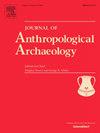New fingerprint evidence for female potters in Late Bronze Age Canaan: The demographics of potters and division of labour at Tel Burna
Abstract
Techno-stylistic studies in ceramic analysis have largely focused on characterising production groups, based on the similarity of various objects and how they were made. The demographics of potters and the division of labour often remain enigmatic in current chaîne opératoire research. A growing number of biometric studies have demonstrated the potential of fingerprints preserved on ceramic surfaces for classifying the age and sex of potters. In this paper, we use a recently introduced identification matrix to model labour divisions based on 52 fingerprints preserved on a diverse range of objects from the Late Bronze Age II stratum at Tel Burna. The sample includes objects from the recently exposed cultic enclosure. Based on broad ethnographic considerations, women were the principal potters in Canaanite society. Our study tests this hypothesis with regards to who made pottery for cultic use. We identify patterns in age categories and a sexual division of labour for the manufacture of select objects and vessel types. The results lead us to discuss possible effects of imperialism on labour organisation. We provide the first compelling insights into the social relations of pottery production at a time when Egypt exercised hegemony over the city-states of the Southern Levant.

 求助内容:
求助内容: 应助结果提醒方式:
应助结果提醒方式:


